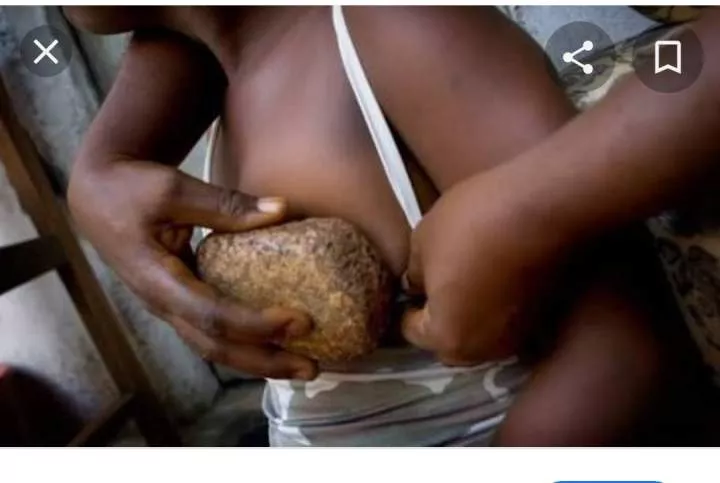Breast ironing: culture that defies modernism

Breast ironing, also known as “breast flattening”, involves repetitive pounding, pressing, ironing, rubbing or massaging of a pubescent girl’s breast through the use of a hard or heated object to delay growth.
According to the United Nations Population Fund (UNFPA), breast ironing practice is reported in African countries like Nigeria, Cameroon, Togo, Guinea Bissau, West and Central Africa, Chad, Benin and Guinea Conakry.
Proponents of the act say it is carried out to protect young girls from unnecessary attention, harassment, abuse, rape, abduction, and forced marriage, among others.
The age-long practice, though not as popular as it used to be in the past, is still being practised in some Nigerian communities.
Martha Sunday, a resident of Kpaduma village, Asokoro in Abuja Municipal Area Council (AMAC), said
that “the act is to protect the virtue of virgin girls.”

Sunday, who confirmed going through the process when she was 10 years old, explained that “breast ironing is done to protect young girls who are getting to puberty age from unnecessary attention.
“When the breast starts sprouting as girls reach puberty age, it attracts attention and harassment.
“It is a painful act, using a hot hard object to rigorously massage the budding breast until it dissolves.
“I still recall the pain, which has left my breast small, disfigured, with low self-esteem and difficulty in breastfeeding my babies.”
According to the United Nations, breast ironing affects 3.8 million women around the world and has been identified as one of the five under-reported Gender-Based Violence (GBV) crimes.
The United Nations Children’s Fund (UNICEF), which said one in every four Nigerian girls has been a victim of GBV and harmful traditional practices, said such victims might be survivors of breast ironing.
Meanwhile, experts have described breast ironing as a form of violence against girls as it causes severe pain, tissue damage, infection and psychological trauma.
Olanike Timipa-Uge, the Executive Director of Teenage Network, a Non-Governmental Organisation (NGO), said the organisation discovered the practice of the age-long tradition during one of its intervention to transform harmful gender norms that promote violence against women and girls in some FCT communities.
She said “It was during the girl’s academy programme that some of the girls opened up and told us about breast ironing.
“The girls said that the act, as claimed by community elders, is to protect them from men.
“We did an in-depth analysis and discovered that one in three girls in Kpaduma and Pygba Sama communities had experienced breast ironing.”
According to her, the organisation, with support from various groups in the communities, embarked on sensitisation to motivate an end to the harmful traditional practice.
She said “We went to other communities and discovered it is a common practice. So, we engaged the media and during one of our radio programmes, many callers narrated their experiences.”

However, contrary to the beliefs of the proponents of the act, the negative consequences supersede the misconceived benefits.
Dr Emmanuel Tabat, a medical practitioner, said ironing prevents the breast from developing.
He told NAN that the act has adverse effects on the girls, listing physical injury, pain and psychological trauma, breast infection and deformity, breastfeeding difficulty, reproductive health issues and increased breast cancer risk.
He said “The pounding and pressing of the breasts can lead to physical injuries such as burns, tissue damage, scarring and infections.
“Breast ironing can also result in changes in breast shape, which can have long-term physical and psychological consequences on the individual.
“While more research is needed in this area, some experts suggest that the repeated trauma and damage to breast tissue caused by breast ironing may increase the risk of developing breast cancer later in life.
“So, for a practice in which the intention or purpose is not achieved by the act, it is obvious that this practice causes more harm than good to the victims,” he said.
Meanwhile, the Federal Government, through the Ministry of Women Affairs, signed a Memorandum of Understanding (MoU) with the Pigba Community in Apo, FCT, for an immediate end to breast ironing practice among young girls.
The Minister of Women Affairs, Uju Kennedy-Ohanenye, while signing the MoU, stressed the need to abolish the practice, and explained its adverse effects.
She said “Breast ironing exposes girls to numerous health problems such as cancer, abscess, itching, and discharge of milk, infection, dissymmetry of the breast and cyst.
“Others are breast infection, severe fever, tissue damage and even the complete disappearance of one or both breasts.
The minister added that the act also traumatises victims and affects their general well-being as future mothers, thus negating President Bola Tinubu’s Renewed Hope Agenda of ensuring the well-being of all Nigerians, including the girl child.
Pledging an end to the age-long traditional practice, Chief Emmanuel Gade, the District Head of Garki Chiefdom in Abuja, assured the government that the community will put an end to the practice, in line with the policy objectives of the present administration.
On her part, Mrs Bassey Ita-Ikpang, the Chairperson, Nigeria Association of Women Journalists (NAWOJ), FCT chapter, emphasised the need for the media to amplify the effects of breast ironing, myths and its consequences on victims.
She said “Some parents do not realise that this act and many other harmful traditional practices do more harm than good to girls.
“There is a need to amplify the negative consequences of the act in media spaces for people to know and to stop the practice.”
Consequently, therefore, there is a need to create more awareness about the devastating effects of carrying out such acts, especially at the grassroots.
The media, government, NGOs and Civil Society Organisations (CSOs) have great roles to play in ending the act through full implementation of the Child Rights Act, the Violence Against Persons Prohibition Act (VAPP) and many other instruments.
The act has been described as “one of the silent harmful practices” to be addressed to stop it from being passed on to generations.




